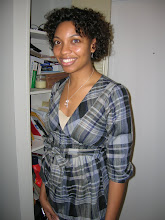It's becoming more clear to me now, how 'unliberal" it can feel being a black female artist. Because there is so much pressure to do this and not do that. If I'm too literal and too open about the stereotypes I might be outcasted by my own, much like how many in the Black community have viewed Kara Walker's work. If I'm not literal enough there isn't much impact at all. So I find myself caught in between a rock in a hard place. There is a huge battle to either just be myself or else no one including myself will get anything out of this.
Recently, I've been watching various videos on Lorna Simpson and Faith Ringgold and it's very interesting to see how different, yet similar they present their art. And somehow I believe the difference in their generation has a great influence. Lorna Simpson using photography, film, installation, and text; Faith Ringgold using painting, quilts, and text. Particularly, I was impressed by them both in how they articulated their process, and which steps in the process are most important for them than others.
For Lorna Simpson while producing the "Public Sex" series it wasn't the image making that is most tasking, it was the printing process; the tediousness, perfectionist process of silkscreen printing her photographic images on felt. I also enjoyed watching her work with the printer to push out all of her images in time for her exhibition. While Faith Ringgold on the other hand shared the harsh realities of being a black female art student in a all-white art school, which sounded all too similar to my own experiences. She had a painting or drawing teacher who told her that she "couldn't" be an artist, and it was at that point that she fought harder to be one. The cleverness in which she choose her medium, quilts, to make it easier, convenient, and economical to be shown in galleries. I took all of that in and it put so many things into perspective for me.
Also, I've been studying about these criticism behind their work and it's mind boggling the depth that can be read behind their images. Oscar called my work "didactic" and too literal, where it didn't allow for multiple readings. When I look at my work I don't know if I see that ,but I can understand why he would say that. I conclude that I worked really hard to make sure that people were able to understand my intent that I didn't leave any space in between. I began to feel that no matter what I did, my work would be interpreted differently and labeled as simply work from a black female artist. I don't believe when I started doing art that I felt it would be that way. I believe I felt that art was this sort of "liberal" and "expressive" world that was down for whatever I had to say. I never imagined that I would be discriminated against, that I would have dealt with the issues I have. Issues of how people preceive the " black female body." I think of some of my early black & white images of black women in dark situations, with one lighting source and I wonder how people w0uld read them. Then, I had no knowledge of the issues dealing with "blackness" in art. Now it seems that my earlier work was more loaded then I thought. Even in my "Covered" series I'm starting to see the implications that I didn't realize were there.
So as I continue on I've purposed to take as much out of these experiences and information as possible. I've started to work on some new images using typography that I will be uploading soon, which will be my attempt to "vomit" some of this information that I've had to take in. It's been a process, and I do believe that I'll be taking many more photographs and designs. I plan to continue on with the bone pieces as well, but there is so much depth there that I want to explore. So everybody get ready.




No comments:
Post a Comment